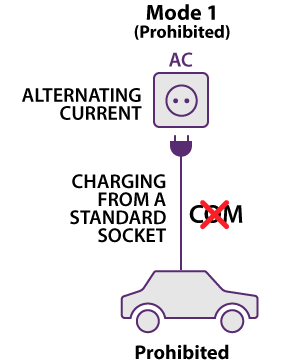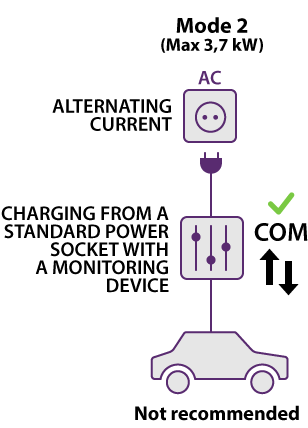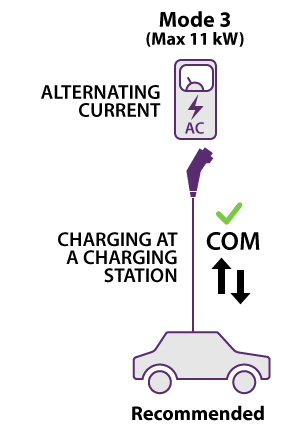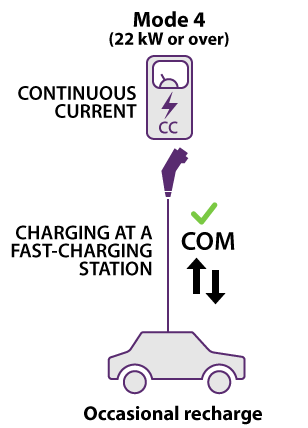

Charging modes define the way in which the electric car and the charging infrastructure communicate. There are several recharging modes depending on the recharging power.
| Please note: Some of the requirements mentioned in this article are specific to the Brussels region. The applicable rules may differ depending upon your region. |

In this charging mode, the electric vehicle is plugged into an ordinary power socket. There is no communication between the vehicle and the charging infrastructure.
This means that there is no charge control and no protection. In Brussels, Mode 1 is accordingly prohibited for charging electric vehicles.Mode 2 : recharge sur une prise domestique

In mode 2, charging is carried out from a household socket using a special cable including a protection device. This casing monitors the load in order to avoid any risk of overheating or overloading. Like a charging point, it can communicate with the electric car in order to ensure a secure connection.
There are several factors to consider when installing a Mode 2 charging system:
This charging mode may be slightly faster than mode 1, but is not recommended for charging electric vehicles. Please note that in Brussels, from 1 January 2025, the installation and use of mode 2 charging points will be prohibited in new buildings or after major renovation.

Mode 3 is the recommended solution for most electric vehicles. In mode 3, the electric vehicle is supplied with alternating current (AC) by a charging station directly connected to the electricity meter via a dedicated circuit. Alternating current is converted by the car into direct current (DC) in order to charge the batteries. Accordingly, the circuit powers no other electrical equipment apart from your vehicle.
Mode 3 enables the smart charging of your vehicle. The station and the car can communicate in order to adapt the charging power to the amount of current available in real time. Depending upon your connection, a mode 3 charging station is capable of supplying much more power than an ordinary household socket.
| Advice! Sibelga has created a simulator which makes it easy to calculate the charging time for your electric car. |

Mode 4 uses direct current (DC) for charging the car's battery directly. It is usually dedicated to fast-charging stations located in public places such as car parks and motorway service areas.
Fast-chargers must be connected to a high-voltage cabin. The high current intensity which they deliver enables them usually to charge up to 80% of an electric car's operating range in less than 30 minutes. Accordingly this makes them ideal for occasional recharging or if you don't have access to private parking.
Given the high power which they deliver, fast-charging stations use special cables and connectors. Usually they offer mode 3 also for cars not equipped for mode 4.
In order to choose the right charging system for your electric car, you need to take into account the type of socket fitted to your vehicle. You should also check the capacity and the type of your connection to the electrical grid.
If you want to install charging stations in your home, we recommend that you call in a professional service provider in order to guarantee the safety of your installation.
In Brussels, Brussels Environment facilitators can also help you in assessing needs and designing the project.
Subscribe to our newsletter and stay informed about energyfacts.